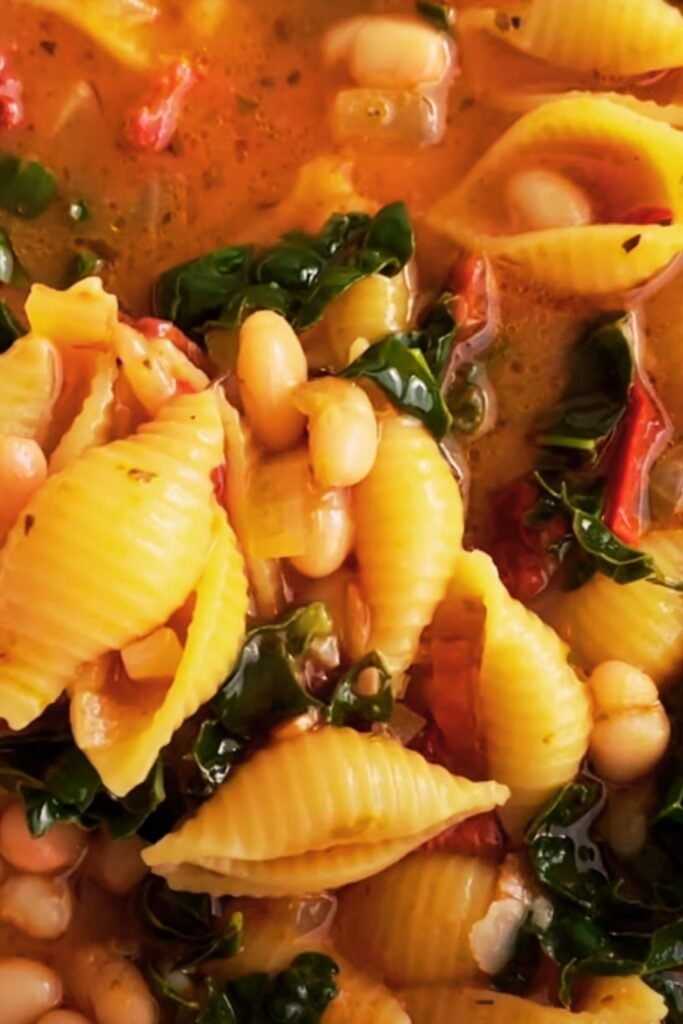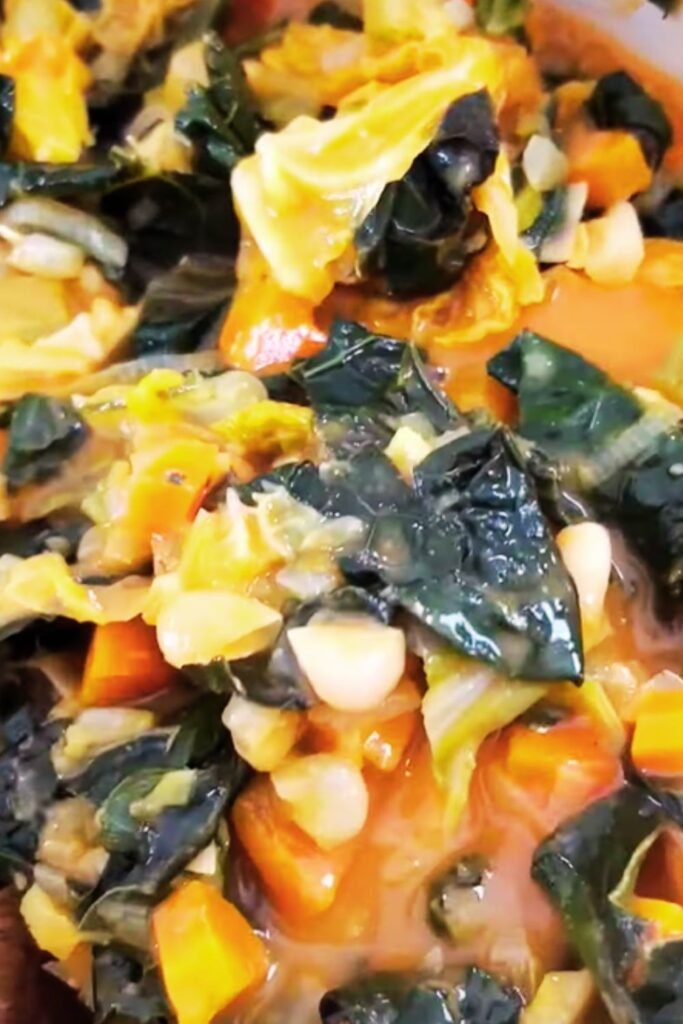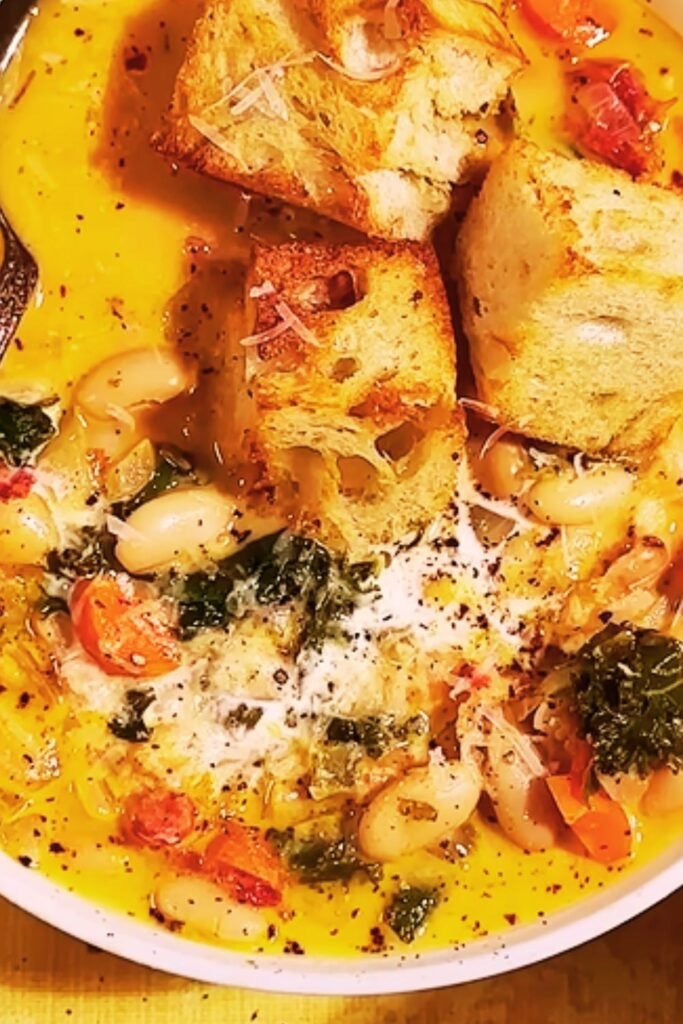When I think about comfort food that nourishes both body and soul, my mind immediately wanders to the rustic kitchens of Tuscany, where simple ingredients transform into extraordinary meals. This Tuscan white bean and kale soup embodies everything I love about Italian cooking – it’s humble yet sophisticated, hearty yet refined, and incredibly satisfying without being heavy.
I’ve been making variations of this soup for years, and it never fails to impress. The combination of creamy cannellini beans, robust kale, and aromatic herbs creates a symphony of flavors that speaks to the very essence of Tuscan cuisine. What makes this recipe particularly special is its simplicity – you don’t need exotic ingredients or complicated techniques to create something truly memorable.
The beauty of this soup lies in its versatility and forgiving nature. Whether you’re cooking for a weeknight dinner or entertaining guests, this recipe adapts beautifully to your needs. I’ve served it as a starter for elegant dinner parties and as a main course for casual family meals, and it’s always received with enthusiasm.
The Heart of Tuscan Cooking
Before diving into the recipe, I want to share what makes Tuscan cuisine so special. The philosophy centers around using the finest ingredients available and letting their natural flavors shine through minimal manipulation. This soup exemplifies that principle perfectly – each ingredient contributes its unique character while harmonizing with the others.
Cannellini Beans: These creamy white beans are the foundation of our soup Kale: Provides earthy robustness and nutritional powerhouse Soffritto: The holy trinity of onion, celery, and carrot that forms the aromatic base Extra Virgin Olive Oil: The liquid gold that brings everything together Fresh Herbs: Rosemary, thyme, and sage that add complexity and authenticity
Essential Ingredients and Their Roles
Understanding each ingredient’s role in this soup will help you make it with confidence and even adapt it to your preferences. I’ve learned through experience that the quality of your ingredients directly impacts the final result.
Primary Ingredients
| Ingredient | Quantity | Purpose | Quality Tips |
|---|---|---|---|
| Cannellini beans | 2 cups dried (or 4 cups canned) | Protein base and creaminess | Look for uniform size, avoid cracked beans |
| Kale | 1 large bunch (about 8 cups chopped) | Nutritional content and texture | Choose younger leaves, avoid yellowing |
| Extra virgin olive oil | 1/4 cup | Flavor foundation and richness | Use cold-pressed, fruity variety |
| Yellow onion | 1 large | Aromatic base | Should be firm with papery skin |
| Celery | 3 stalks | Flavor depth | Crisp stalks with fresh leaves |
| Carrots | 2 medium | Natural sweetness | Firm, bright orange color |
| Garlic | 6 cloves | Aromatic intensity | Fresh, plump cloves |
| Vegetable broth | 8 cups | Liquid foundation | Low-sodium preferred |
| Crushed tomatoes | 1 can (14 oz) | Acidity and color | San Marzano preferred |
| Fresh rosemary | 2 sprigs | Aromatic complexity | Needle-like leaves, fragrant |
| Fresh thyme | 1 tablespoon | Earthy notes | Small, gray-green leaves |
| Fresh sage | 8 leaves | Distinctive flavor | Velvety, silver-green leaves |
Secondary Ingredients
| Ingredient | Quantity | Purpose | Notes |
|---|---|---|---|
| Bay leaves | 2 | Background flavor | Remove before serving |
| Sea salt | To taste | Flavor enhancement | Start with 1 teaspoon |
| Black pepper | To taste | Gentle heat | Freshly cracked preferred |
| Red pepper flakes | 1/4 teaspoon | Optional heat | Adjust to preference |
| Parmigiano-Reggiano | 1/2 cup grated | Finishing touch | Aged 24 months ideal |
| Lemon juice | 2 tablespoons | Brightness | Fresh squeezed only |
Step-by-Step Preparation
My approach to this soup emphasizes building layers of flavor at each stage. The key is patience – rushing the process will result in a good soup, but taking time creates something extraordinary.

Preparing the Beans
If using dried beans, I always recommend soaking them overnight. This not only reduces cooking time but also ensures even cooking and better texture. Here’s my method:
- Rinse and sort the dried beans, removing any debris or damaged beans
- Soak overnight in cold water, using a ratio of 3:1 water to beans
- Drain and rinse before cooking
- Cook gently in fresh water until tender, about 1-2 hours depending on age
For canned beans, I drain and rinse them thoroughly to remove excess sodium and the sometimes metallic taste from the can.
Creating the Soffritto
The soffritto is the aromatic foundation of our soup, and I take great care in preparing it properly:
- Dice the vegetables uniformly – onion, celery, and carrot should be roughly the same size
- Heat olive oil in a heavy-bottomed pot over medium heat
- Add vegetables and cook slowly, stirring occasionally, for 8-10 minutes
- Season lightly with salt to help draw out moisture
- Cook until softened but not browned – we want sweet, caramelized flavors
Building the Soup Base
Once the soffritto is ready, I add the remaining ingredients in a specific order to maximize flavor development:
- Add minced garlic and cook for 30 seconds until fragrant
- Add herbs (rosemary, thyme, sage) and cook briefly to release oils
- Pour in crushed tomatoes and cook for 3-4 minutes to concentrate flavors
- Add cooked beans and stir to combine
- Pour in vegetable broth gradually, stirring constantly
- Add bay leaves and bring to a gentle simmer
Incorporating the Kale
Kale requires special attention to achieve the perfect texture. I’ve found that timing is crucial:
- Remove tough stems and chop leaves into bite-sized pieces
- Add to soup during the last 10 minutes of cooking
- Stir gently to prevent breaking up the beans
- Cook until tender but still vibrant green

Cooking Techniques and Tips
Over the years, I’ve developed several techniques that elevate this simple soup from good to exceptional. These details might seem minor, but they make a significant difference in the final result.
Temperature Control
Maintaining the right temperature throughout cooking is crucial. I keep the soup at a gentle simmer – vigorous boiling will break up the beans and create a muddy texture. The surface should barely bubble, with occasional gentle movement.
Seasoning Strategy
I season in stages rather than all at once:
- Early seasoning: Light salt with the soffritto to draw out flavors
- Mid-cooking: Taste and adjust after adding broth
- Final seasoning: Just before serving, with salt, pepper, and lemon juice
Texture Considerations
For optimal texture, I partially puree about one-third of the soup. This creates a creamy base while maintaining interesting texture from whole beans and vegetables. I use an immersion blender for this, pulsing carefully to avoid over-processing.
Nutritional Benefits
This soup isn’t just delicious – it’s incredibly nutritious. The combination of beans, kale, and vegetables creates a powerhouse of nutrients that supports overall health and well-being.
Nutritional Breakdown per Serving
| Nutrient | Amount | % Daily Value | Health Benefits |
|---|---|---|---|
| Calories | 285 | 14% | Balanced energy source |
| Protein | 15g | 30% | Muscle maintenance and repair |
| Fiber | 12g | 48% | Digestive health and satiety |
| Iron | 4.2mg | 23% | Oxygen transport and energy |
| Calcium | 180mg | 18% | Bone health and muscle function |
| Vitamin A | 8,500 IU | 170% | Vision and immune function |
| Vitamin C | 85mg | 94% | Immune support and collagen |
| Folate | 120mcg | 30% | Cell division and DNA synthesis |
| Potassium | 890mg | 25% | Heart health and blood pressure |
| Magnesium | 85mg | 21% | Muscle and nerve function |
Health Benefits
Cardiovascular Health: The high fiber content and potassium help maintain healthy blood pressure and cholesterol levels. The beans provide plant-based protein without saturated fat.
Digestive Health: The combination of fiber from beans and kale promotes healthy digestion and feeds beneficial gut bacteria.
Immune Support: Kale’s vitamin C content, combined with the antioxidants from herbs and vegetables, supports immune function.
Bone Health: The calcium and vitamin K from kale contribute to bone density and strength.
Weight Management: High fiber and protein content promote satiety, helping with portion control and weight maintenance.
Serving Suggestions and Pairings
This soup is incredibly versatile and can be served in numerous ways. I’ve enjoyed it as both a starter and main course, and it pairs beautifully with various accompaniments.
Bread Pairings
- Crusty Italian bread – traditional and perfect for dipping
- Focaccia – herb-topped varieties complement the soup’s flavors
- Cornbread – adds a slightly sweet contrast
- Whole grain rolls – increases the meal’s nutritional value
Protein Additions
While the soup is satisfying on its own, I sometimes add:
- Italian sausage – removed from casings and browned before adding
- Pancetta – diced and rendered for extra richness
- Grilled chicken – shredded and stirred in just before serving
- Parmesan rind – simmered in the soup for extra depth
Garnish Options
The right garnish can transform the presentation and add final flavor notes:
- Fresh herbs – chopped parsley, basil, or rosemary
- Grated cheese – Parmigiano-Reggiano or Pecorino Romano
- Olive oil drizzle – high-quality extra virgin
- Lemon zest – adds brightness and aroma
- Toasted pine nuts – for texture and richness

Storage and Reheating
This soup actually improves with time, as the flavors continue to meld and develop. I often make large batches specifically for leftovers and meal prep.
Storage Guidelines
Refrigerator: Store in airtight containers for up to 5 days. The soup will thicken considerably as it cools, which is normal.
Freezer: Freeze for up to 3 months in freezer-safe containers. Leave some headspace for expansion.
Portioning: I freeze individual portions for easy reheating and portion control.
Reheating Instructions
Stovetop: Reheat gently over medium-low heat, stirring occasionally. Add broth or water if needed to achieve desired consistency.
Microwave: Heat in 30-second intervals, stirring between each interval to ensure even heating.
From Frozen: Thaw overnight in refrigerator before reheating, or reheat directly from frozen over very low heat.
Variations and Adaptations
One of the things I love most about this recipe is its adaptability. I’ve created numerous variations based on seasonal availability and personal preferences.
Seasonal Adaptations
Spring: Add fresh peas and baby spinach instead of kale Summer: Include zucchini and fresh basil Fall: Add butternut squash and sage Winter: Include root vegetables like parsnips and turnips
Dietary Modifications
Vegan: Use vegetable broth and skip the Parmesan Gluten-Free: Ensure broth is gluten-free certified Low-Sodium: Use low-sodium broth and season with herbs instead of salt Protein-Boosted: Add cooked quinoa or lentils
International Variations
Spanish-Style: Add smoked paprika and chorizo Greek-Style: Include lemon juice and oregano Mexican-Style: Add cumin, chili powder, and lime Indian-Style: Include curry powder and coconut milk
Troubleshooting Common Issues
Through years of making this soup, I’ve encountered and solved various challenges. Here are the most common issues and their solutions:
Problem-Solution Guide
| Issue | Cause | Solution |
|---|---|---|
| Beans falling apart | Overcooking or old beans | Use fresher beans, cook gently |
| Soup too thin | Not enough beans or cooking time | Puree more beans, simmer longer |
| Soup too thick | Over-reduction or too many beans | Add more broth gradually |
| Lack of flavor | Under-seasoning or poor ingredients | Season in stages, use quality ingredients |
| Kale too tough | Overcooked or mature leaves | Use younger leaves, shorter cooking time |
| Greasy surface | Too much oil or fat | Skim surface, reduce oil |
| Bitter taste | Overcooked garlic or herbs | Cook garlic gently, add herbs late |
Frequently Asked Questions
Q: Can I use other types of beans instead of cannellini? Yes, absolutely! Great Northern beans, navy beans, or even chickpeas work wonderfully. Each brings slightly different texture and flavor profiles, but all are delicious.
Q: How do I know when the dried beans are properly cooked? The beans should be tender when pressed between your fingers but still hold their shape. They shouldn’t be mushy or have tough centers.
Q: Can I make this soup in a slow cooker? Definitely! Cook on low for 6-8 hours or high for 3-4 hours. Add the kale in the last 30 minutes of cooking.
Q: What if I can’t find fresh herbs? Dried herbs work fine, but use about one-third the amount. Add them earlier in the cooking process to allow their flavors to develop.
Q: How can I make this soup more filling? Add cooked pasta, rice, or quinoa. Small shapes like ditalini or orzo work particularly well.
Q: Is this soup suitable for freezing? Yes, it freezes beautifully for up to 3 months. The texture may change slightly, but the flavor remains excellent.
Q: Can I use frozen kale? Fresh kale is preferred for texture, but frozen kale works in a pinch. Thaw and drain it thoroughly before adding to the soup.
Q: How do I prevent the soup from being too salty? Use low-sodium broth and season gradually. Remember that flavors concentrate as the soup reduces.
Q: What’s the best way to prepare kale for this soup? Remove the tough stems and chop the leaves into bite-sized pieces. Massage them lightly with a bit of salt to break down the fibers.
Q: Can I add other vegetables to this soup? Absolutely! Zucchini, bell peppers, or spinach all work well. Add them according to their cooking times.
This Tuscan white bean and kale soup represents everything I love about cooking – it’s simple enough for a weeknight meal yet sophisticated enough for entertaining. The combination of wholesome ingredients, traditional techniques, and personal touches creates something truly special. I encourage you to make this recipe your own, adjusting seasonings and ingredients to suit your taste preferences. The beauty of this soup lies not just in its delicious flavor, but in its ability to nourish both body and soul, connecting us to the timeless traditions of Tuscan cooking.
Whether you’re seeking comfort after a long day, looking for a nutritious meal option, or wanting to impress guests with authentic Italian flavors, this soup delivers on all counts. The rich, satisfying broth, creamy beans, and tender kale create a harmony of flavors that will have you returning to this recipe again and again. I hope it becomes as beloved in your kitchen as it has in mine.